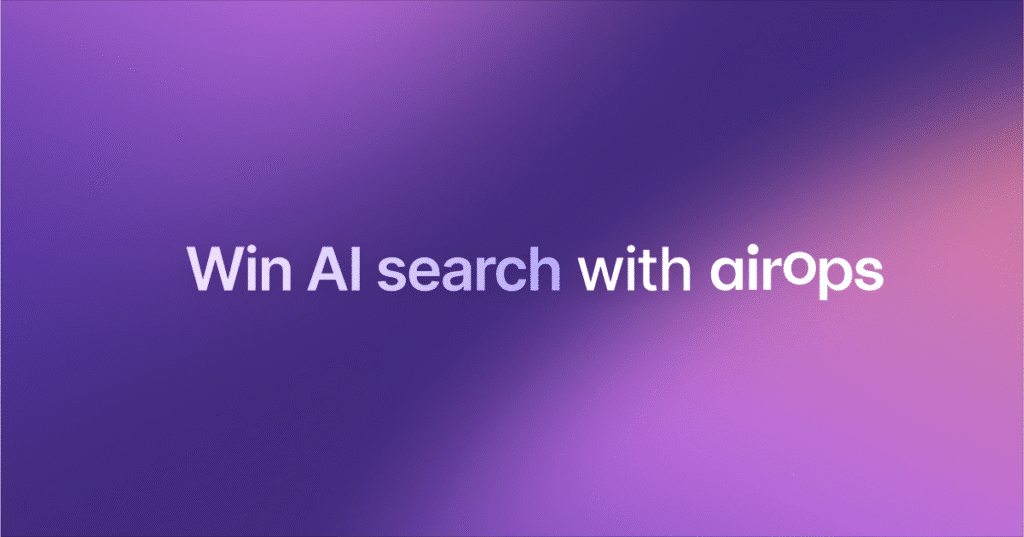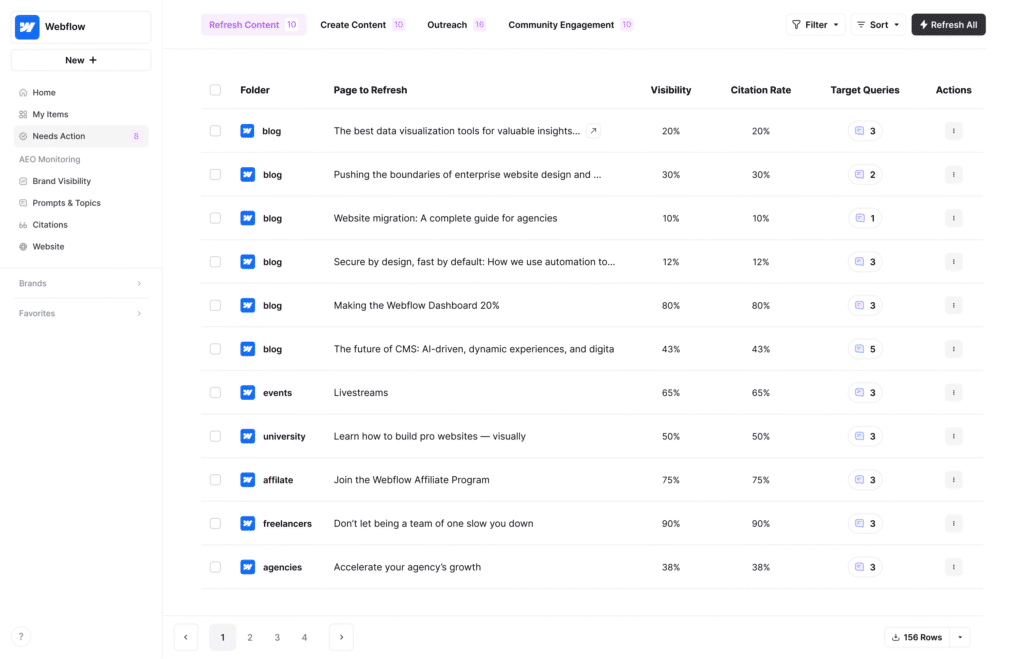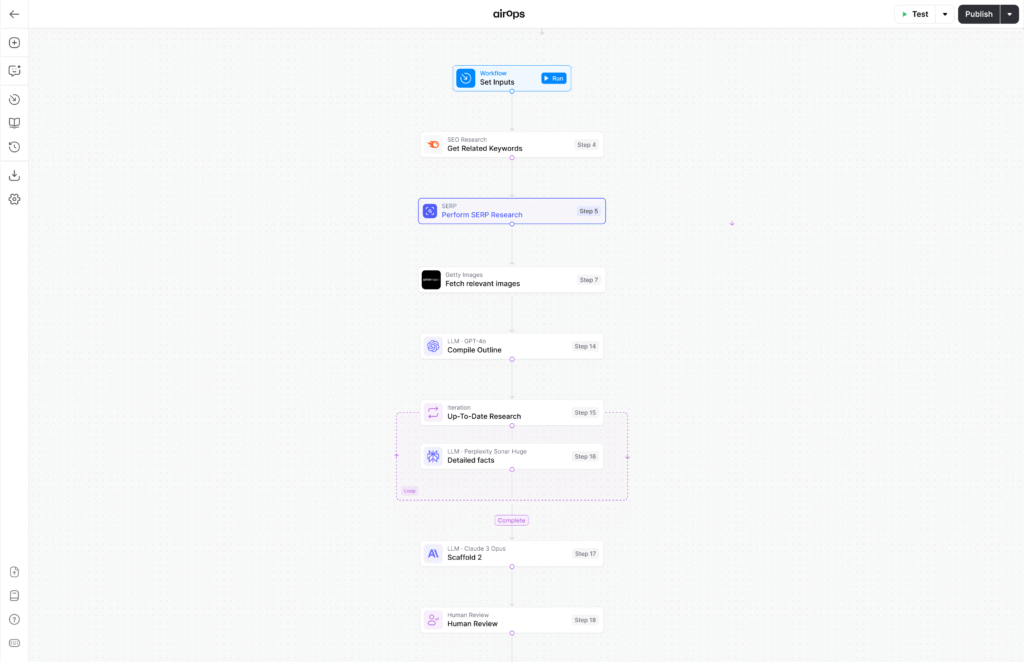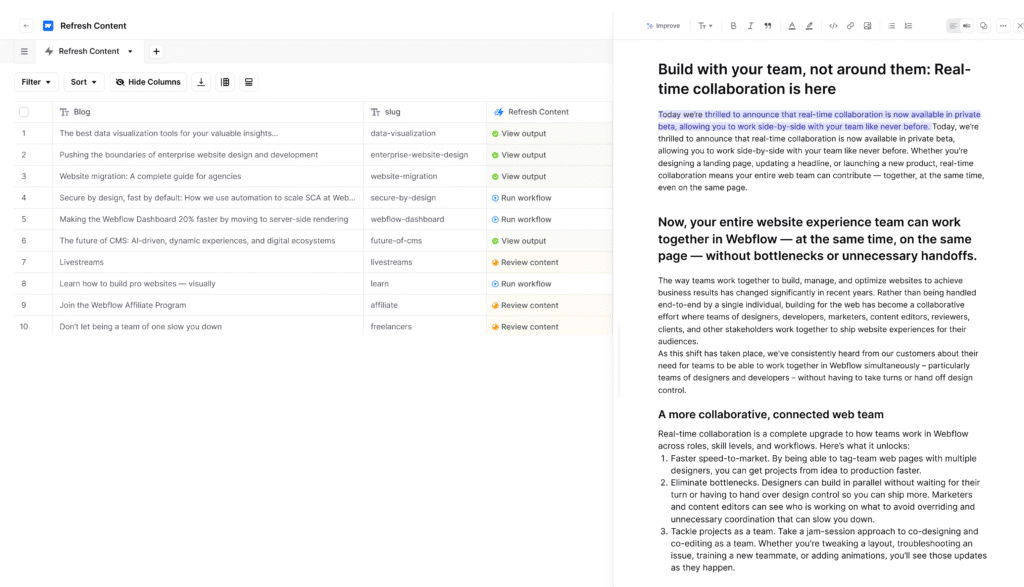You have a content strategy that works. The bottleneck isn’t your ideas; it’s execution speed.
Manual production is too slow to compete, but standard AI writing tools are a non-starter. This leaves you stuck, forced to choose between the quality that built your brand and the quantity needed to grow.
AirOps is an AI workflow platform designed to amplify your strategy by scaling your proven processes while maintaining quality. Recently, it has expanded its mission by pivoting into AI search visibility.
But has it successfully made that leap, or is it a production tool stretched too thin? This AirOps review looks into the platform’s features, performance, and real user feedback to determine if it’s the right fit for your team.
What Is AirOps and How Does It Work?
AirOps is a no-code workflow platform designed for established content and SEO teams that need to scale their operations.

Unlike simple AI writers, it’s a system designed to automate an existing, proven content strategy and is used by high-performing teams at companies like Webflow, Ramp, Descript, and Carta.
Originally focused on content production, AirOps has recently expandeits capabilities to include search visibility insights and analytics.

The platform is built around what it markets as an “Insights to Action” model. This process is designed to first provide data on a brand’s AI search visibility (”Insights”) and then provide the tools to improve it (”Actions”).
According to its marketing, these actions fall into four primary areas:
- Refreshing existing content to win citations, which are direct, attributable links back to one of your pages from within an AI answer.
- Creating new content to fill competitive gaps
- Winning back third-party mentions through outreach, which is when an AI references your brand or product by name without a link.
- Engaging in relevant social media conversations
This framework makes AirOps an integrated system for managing a brand’s presence in AI-driven conversations.
AirOps’ Features
Among AirOps’s features, some are dedicated to content production and others have been added recently to help you with AI seach visibility.
AI Search Visibility Insights
This is the platform’s analytics dashboard. It shows how a brand is performing in AI search: where it’s showing up, how often, and how it stacks up against competitors.

Available only on the custom-priced paid plans, this feature tracks visibility across platforms like ChatGPT, Gemini, and Perplexity.
It surfaces where competitors are being cited, flags gaps in your own coverage, and helps you prioritize which content to create or refresh. It doesn’t show metrics only; it shows you which queries matter, which answers models are generating, and where your brand is missing from the conversation.
It serves as the “Insights” portion of the platform’s “Insights to Action” model.
Brand Kits for Voice Control
To make sure AI-generated content aligns with a company’s specific voice, the Brand Kits feature creates a reference library for the AI to use.
Users can upload style guides, sample articles that represent the desired tone, lists of preferred terminology, and descriptions of the target audience. The AI then uses this kit as a guide during the content generation process.
No-Code Workflow Builder
The platform includes a visual workflow builder that lets users to automate content processes without writing code.

Inside the builder, users can chain together modular steps and AI models to create a reusable workflow. Each step handles a specific task (like pulling SERP data, generating outlines, or running fact checks), and the entire flow can be customized to match your team’s process.
For example, a user might connect a “SERP Analysis” step (using SEMrush data) to a “Generate Outline” step (using Claude”, followed by a “Human Review” step, and then a final “Write Draft” step (using GPT-5).
Once built, the workflow can be reused across campaigns, scaled across teams, or tweaked for different verticals. It’s unlike triggering prompts; it’s a system that runs end-to-end.
Grids
The Grids feature is essentially a content operations dashboard that integrates planning with execution.
Instead of managing an editorial calendar in a separate spreadsheet, this feature lets content managers view the full calendar, track the status of each article (”To Do,” “In Progress,” “Published”), and trigger workflows directly from the same interface.
Each entry is connected to its production logic. So, if a piece is marked “To Do,” you can launch a prebuilt workflow to generate a brief assign a writer, or push it into review.
Grids replace the usual patchwork of spreadsheets, task boards, and disconnected tools with a single system that links editorial planning to actual output.
Human-in-the-Loop Review
This feature serves as a quality control checkpoint within any workflow.

When a workflow reaches a designated review step, it pauses and notifies an editor.
The system holds until a human team member manually approves, edits, or rejects the AI-generated content. Nothing moves forward until that review is complete.
This is built to prevent blind automation and make sure that every output passes through human oversight and is checked for its quality before going live.
This step can be placed anywhere in the workflow, whether after outline generation, draft creation, or final formatting. It’s especially useful for regulated industries, brand-sensitive content, or any team that needs editorial control baked into the automation.
Power Steps (SEO Templates)
Power steps are pre-configured templates for common SEO tasks that can be dropped into any workflow.
These include modules for SERP analysis, content gap identification, and meta description optimization. Each one is built to handle a specific task without needing manual setup.
Instead of building a workflow from scratch, users can drag in a Power Step, tweak the inputs, and run it instantly. It’s designed to reduce friction and make SEO execution repeatable at scale.
For example, a content strategist might use a SERP Analysis Power Step to pull competitor rankings, then follow it with a Gap Identification module to flag missing topics, and finish with a Meta Optimization step to rewrite descriptions using model-generated suggestions. Each module is plug-and-play and customizable.
Direct CMS and SEMrush Integrations
AirOps is built to connect with a standard content and SEO tech stack.
- CMS Integrations: It connects directly with WordPress, Webflow, and Shopify. You can publish approved content without manual copy-pasting. Once a piece clears review, it can be pushed live from within the workflow without tool-switching.
- SEMrush Integration: On paid plans, you can pull keyword data, search volumes, and competitor analysis directly from SEMrush into your workflows to automate the research phase and ground your content in real search behavior.
AirOps Pricing Breakdown
AirOps uses a freemium pricing model with three main tiers: Solo, Scale, and Agency. As of October 2025, the features are distributed as follows, with the “AI Search Visibility Insights” locked behind custom-priced plans.
| Feature | Solo Plan | Scale Plan | Enterprise Plan |
|---|---|---|---|
| Price | Free | Custom | Custom |
| Best For | Solo creators and testing | Growing content teams | Agencies and large enterprises |
| AI Search Visibility | ❌ | ✔️ | ✔️ (Customized) |
| Users | 1 User | Unlimited Users | Unlimited Users |
| Brand Kits | 1 | 3 | Unlimited |
| Support | Community and live chat | Account manager and private Slack | 1:1 expert onboarding |
The Free “Solo” plan includes access for one user to the basic workflow builder and community support, but it doesn’t include the AI Search Visibility features.
The “Scale” plan is designed for growing teams and introduces the visibility insights, unlimited users, and dedicated support via a private Slack channel.
The “Enterprise” plan is for large-scale operations and includes advanced customization, 1:1 onboarding, and multi-account integrations for agencies.
Both the Scale and Enterprise plans require contacting the sales team for a custom price.
Airps Features: Strengths
For its target audience of established content teams, AirOps features three useful workflows that streamline content prodction.
- Workflow automation for content operations: The platform is purpose(built for content-related tasks. Features like the Grids interface, bulk actions, and direct CMS publishing are designed to address common pain points in a high-volume content program.
- Brand voice and quality control: The combination of Brand Kits (which provide style guidelines to the AI) and human-in-the-loop review checkpoints allows teams to maintain editorial oversight and brand consistency, even when automating content production.
- Efficiency in content refresh projects: One of the platform’s most cited use cases is automating large-scale content refresh projects. The system can handle research, updating, and optimization for hundreds of existing articles, which can make previously time-consuming projects more manageable.
AirOps Features: Weaknesses
However, depending on your team’s resources and primary goals, you should be aware of several factors that could present challenges.
- Steep learning curve: This isn’t a “plug-and-play” tool. User feedback on platforms like G2 consistently highlights a steep learning curve that requires a notable time investment to master the workflow builder.
- Requires an existing strategy: AirOps is a tool for execution and amplification, not for strategy creation. It’s most effective when used to scale a content process that’s already proven to work. It doesn’t provide foundational SEO or content strategy guidance.
- Limited visibility analytics: While the platform has added “AI search visibility insights,” its architecture is for workflow automation. Teams whose primary need is comprehensive, specialized analytics may find the insights less complete than those of a dedicated generative engine optimization (GEO) platform.
- Non-transparent pricing: The “contact sales” model for the Scale and Agency plans, where the main visibility features are located, is a point of friction. This makes it difficult for teams to budget and compare costs without engaging in a sales process.
What Users Think About AirOps
Verified AirOps reviews on software websites are few and far in-between. On G2, it holds a strong rating, but a closer look at user feedback reveals that users value the platform’s power and support but are frequently frustrated by a lack of clarity and technical bugs. On G2
Positive feedback frequently commends the platform’s excellent customer support, which users say assists seamlessly with setup and learning. Other praised aspects include the customization options for building complex workflows and the accessible, ready-made steps that benefit beginners.
On the other hand, critical users consistently point out that the platform’s credit system is unclear. Their sources of frustration include “unclear limits” and confusing “testing credits.” Other reported issues include software bugs, such as unresponsive grids and difficult navigation.
In short, this user feedback shows that AirOps is powerful and flexible but still working through issues related to usability, transparency, and stability.
Who Should Use AirOps?
AirOps is a demanding tool, and its success entirely on having the right team and strategy in place before you start.
It’s best suited for established content teams or agencies with a proven strategy that’s slowed by manual execution, especially those running large-scale refresh projects and comfortable with workflow-based tools.
But it’s not ideal for beginners in SEO, solo marketers, or teams seeking deep AI visibility tracking, as it amplifies existing systems rather than building them.
The companies seeing exceptional results with AirOps, like Webflow and Descript, automated processes that were already working. They didn’t buy a strategy; they bought a way to scale one.
Is AirOps the Right Tool for You?
The decision to invest in AirOps depends on your team’s primary bottleneck and existing level of strategic maturity.
The platform is an effective content production and workflow automation tool. For teams with a proven content playbook who are struggling with the manual effort of execution, AirOps can provide a clear return on investment through efficiency gains.
However, its capabilities are most focused on production, not analytics. While the platform has added AI search visibility features, this is a secondary function. For teams whose primary challenge is a lack of comprehensive visibility data to inform their strategy, a more specialized GEO platform may be a better fit.
Assess your primary need. If your bottleneck is the speed of execution for a strategy you already have, AirOps is a logical contender.
If your bottleneck is a lack of strategic insights to guide your content in the first place, a dedicated visibility and analytics platform like GetMint solves that problem.
Frequently Asked Questions (FAQs)
How much does AirOps actually cost?
AirOps offers a free “Solo” plan with limited tasks. The “Scale” and “Agency” plans, which include the core AI Search Visibility features, require contacting their sales team for a custom price. Based on user discussions and similar platforms, expect these plans to start in the $299−500+/month range depending on volume.
Can AirOps replace my content team?
No. AirOps is a tool to amplify your existing team’s expertise, not a replacement for it. It automates repetitive tasks and scales execution, but you still need humans to set the strategy, review the AI-generated outputs, and provide the final editorial judgment.
How does AirOps compare to GetMint?
The two platforms solve different problems. AirOps is primarily a content production workflow tool designed to help you create and refresh content at scale.
GetMint is a specialized AI search visibility platform that provides deep analytics on how your brand is being cited and mentioned, helping you build and refine your strategy and address these visibility gaps with its dedicated Content Studio.
Can I track AI citations with AirOps?
Yes, but with limitations. The paid “Scale” plan and above include “AI Search Visibility Insights,” which can track citations and mentions. However, this is a newer feature and isn’t as comprehensive or specialized as dedicated GEO tracking platforms. For accurate and multi-platform citation and mention monitoring, a tool like GetMint provides deeper, more comprehensive data.
Is AirOps easy to use for beginners?
No. User feedback on G2 consistently highlights a steep learning curve. While it’s a no-code platform, building effective workflows requires a significant time investment in learning the tool and thinking in terms of automation. It’s not a “plug-and-play” solution.
Does AirOps integrate with WordPress?
Yes. AirOps integrates directly with WordPress, Webflow, and Shopify, allowing you to publish approved content directly from your workflow to your CMS without manual copy-pasting.
What is the difference betwee SEO, GEO, and AEO?
GEO and AEO are often used interchangeably, but there are distinct differences between these three disciplines.
The goal behind SEO is to rank high in the traditional list of blue links and win the click. For AEO, the goal is to become the direct answer on a Google search results page (e.g., in a Featured Snippet). Differently, GEO helps you get cited or mentioned as a source or solution within a conversational AI platform like ChatGPT.





